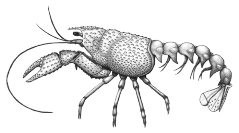

 Geodiversitas
43 (2) - Pages 25-73
Geodiversitas
43 (2) - Pages 25-73Erymoid lobsters (Crustacea, Decapoda, Erymoidea) are an important component of Mesozoic crustacean faunas in Europe, especially during the Jurassic. With 36 species reported, these lobsters reach their highest diversity during the Late Jurassic. After the review presented here, 23 species belonging to Eryma Meyer, 1840 (11 species), Palaeastacus Bell, 1850 (2 species), Pustulina Quenstedt, 1857 (2 species) and Stenodactylina Beurlen, 1928 (8 species) remain valid. One new species is described: Stenodactylina shotoverigiganti n. sp., and Eryma pseudoventrosa Beurlen, 1928 is integrated to Stenodactylina. We also notice the oldest representative of Enoploclytia M’Coy, 1849, known by a single specimen unidentified at specific level. Eryma ventrosum (Meyer, 1835) is the most common species in Western Europe, and may be seen as emblematic of the Middle – Late Jurassic. Moreover, the lithographic limestones of Germany yield an exceptionally diversified erymoid fauna, with four genera (Eryma, Palaeastacus, Pustulina, Stenodactylina) and 11 species listed. All the Late Jurassic representatives of Palaeastacus were found in this lithology. Finally, the examination of some specimens allows the observation of the strong effects of the decortication on the ornamentation of the erymoids and the resulting taxonomic issues.
Mesozoic, Erymoidea, Erymidae, lobster, decortication, Lagerstätte, palaeobiodiversity, Western Europe, new synonyms, new combination, new species